Site Search
- resource provided by the Forum Network Knowledgebase.
Search Tip: Search with " " to find exact matches.
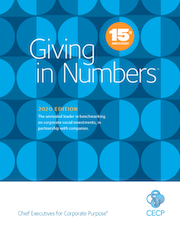
CECP’s Giving in Numbers™is the unrivaled leader in benchmarking on corporate social investments, in partnership with companies. It is the premier industry survey and research, providing standard-setting criteria in a go-to guide that has defined the field and advanced the movement. CECP has the largest and most historical data set on trends in the industry, shared by more than 585 multi-billion-dollar companies over nearly 19 years, representing more than $312 billion in corporate social investments over that time span. The report is embraced by professionals across all sectors globally to understand how corporations invest in society, with topics ranging from cash and in-kind/product, employee volunteerism and giving, and impact measurement.
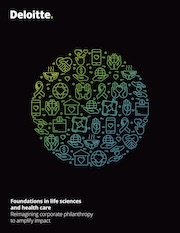
The New Jersey Arts and Culture Recovery Fund has awarded $1.3 million in grants to 68 nonprofits across the state in an effort to help them recover from the devastating effects of the pandemic.
This is the second round of grants awarded by NJACRF, which is hosted by the Princeton Area Community Foundation. Earlier this year, the fund provided $2.6 million in grants to more than 100 other arts, culture and historical nonprofits statewide.
COVID-19 shuttered venues and forced furloughs and layoffs of more than half of the state’s creative workforce. The state’s nonprofit arts industry reported pandemic-related losses of more than $100 million as of December.
In response to the needs of the arts community, NJACRF was established last year with a gift from the Grunin Foundation, based in Toms River. A coalition of funders quickly followed with their support, to ensure the recovery of the industry.
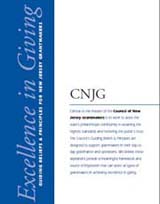
This includes insights and tips related to board governance, legal compliance, grantee communications, fiscal responsibility, public disclosure, and many other key areas of foundation governance and operations. It is intended to serve as a practical resource to assist foundations in their grantmaking.
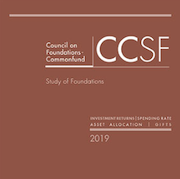
The CCSF report is the field’s most comprehensive and authoritative study on investment and governance policies and practices. The 2019 CCSF studies 265 private and community foundations that represent $104.7 billion in assets. Topics covered include:
- Returns and Investment Objectives
- Asset Allocation and Responsible Investing Criteria
- Responsible Investment Practices
- Fund Flows, Spending and Gifts
- Resources, Management and Governance
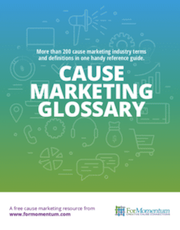
This handy reference tool contains the definitions for over 250 cause marketing industry terms used by savvy businesses and nonprofit organizations. When you meet with partners, whether you are a corporation or a nonprofit, it’s always beneficial to speak their language and show them that you fully understand their marketing landscape. We’ve taken some buzzwords straight from this year’s headlines and added others that have been around awhile but have taken on added importance in 2019.
Philanthropy and the Social Economy: Blueprint 2017 is an annual industry forecast about the ways we use private resources for public benefit.
Foundation Center is pleased to again partner with Lucy to offer the Blueprint as a GrantCraft guide. The Blueprint provides an overview of the current landscape, points to major trends, and directs your attention to horizons where you can expect some important breakthroughs in the coming year.
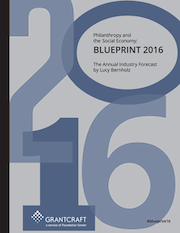
Philanthropy and the Social Economy: Blueprint 2016 is an annual industry forecast about the ways we use private resources for public benefit.
Foundation Center is pleased to again partner with Lucy Bernholz to offer the Blueprint as a GrantCraft guide. The Blueprint provides an overview of the current landscape, points to major trends, and directs your attention to horizons where you can expect some important breakthroughs in the coming year.
This weekly conference call series welcomed New Jersey-based grantmakers along with national funders and provided an opportunity for grantmakers to hear from a wide range of experts in the field of disaster philanthropy. This series started on September 9, 2013 and concluded on November 4, 2013. The written summaries of each recording are listed below.
The Inclusive Growth ScoreTM provides local planners, governments and impact investors with a clear, simple view of social and economic indicators for any census tract in the United States.
The New Jersey Bankers Association’s Charitable Foundation recently announced it will donate $50,000 to the veterans’ programs at four New Jersey colleges: Fairleigh Dickinson University, Monmouth University, Rider University and Rutgers University.
The donations will be awarded in January.
“The New Jersey banking industry has always made giving back, and supporting our local institutions, a priority,” NJBankers CEO John McWeeney said. “Our ongoing support of these valuable programs allows us to recognize those men and women who have volunteered to protect our country in the armed forces.”
President Obama's Hurricane Sandy Task Force released this rebuilding strategy to serve as a model for communities across the nation facing greater risks from extreme weather and to continue helping the Sandy-affected region rebuild. The Rebuilding Strategy contains 69 policy recommendations, many of which have already been adopted, that will help homeowners stay in and repair their homes, strengthen small businesses and revitalize local economies and ensure entire communities are better able to withstand and recover from future storms.
Native Voices Rising is a joint research and re-granting project of Native Americans in Philanthropy and Common Counsel Foundation. This report focuses on the practices and challenges of community organizing and advocacy, focusing on the need for increased investment in and sustained support for American Indian, Alaska Native and Native Hawaiian communities.
This weekly conference call series welcomed New Jersey-based grantmakers along with national funders and provided an opportunity for grantmakers to hear from a wide range of experts in the field of disaster philanthropy. Series 1 started on November 5, 2012, one week after Sandy struck New Jersey, and continued through March 25, 2013. Series 2 started on September 9, 2013 and concluded on November 4, 2013. The written compendium of the recordings is listed below.
